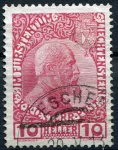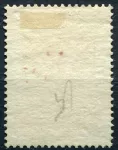- Home
- Philately: postage stamps
- Philately: stamps all over the world
- Europe
- Liechtenstein
- cancelled
- (1912) MiNr. 2 x - O - Liechtenstein - 80th birthday of Prince Johann II.
(1912) MiNr. 2 x - O - Liechtenstein - 80th birthday of Prince Johann II.
Liechtenstein - postage stamps



| Code: | LCHT-2xr |
| Producer: | Lichtenštejnsko |
| Price: | 3,46 EUR |
| Availability: | Sold out - do not order! |
| Stock: | 0 Pcs |
| Denomination of the stamp: | 10 Hel. |
| Year: | 1912 |
| Condition: | O |
| Cat. number (Zumstein): | 2x |
| Catalogue no. (MICHEL): | 2x |
| Cat. number (St. Gibbons): | 2 |
| Cat. number (Yvert et Tellier): | 2 |
| Catalogue Price: | 20 ,- Mi€ |
Prince Johann II of Liechtenstein: personality and significance for the history of the Principality
Johann II of Liechtenstein, also nicknamed Johann II. He reigned for over seventy years, making him one of the longest reigning monarchs in European history. His reign was associated with extensive reforms, modernisation of the state and support for science, the arts and charitable projects.
Early life and ascension to the throne
He was born on 5 October 1840 in Vienna, the eldest son of Prince Alois II. He was educated in the Viennese aristocracy, where he was shaped by the classical humanities and an interest in the natural sciences. After the death of his father, at the age of only eighteen, he became ruler of the Duchy of Liechtenstein, which was then a small but stable state within the Austrian Empire.
Reforms and modernization
Johann II introduced a series of social, economic and administrative reforms that aimed to raise the standard of living of the population and ensure the long-term stability of the state. He supported the introduction of modern education, the transition to a constitutional monarchy, and was known for his responsiveness to the demands of the population.
During his reign, the principality obtained the Constitutional Act of 1921, which laid the foundations for the modern form of the state, including the division of powers between the monarch, parliament and government.Support for science and the arts
One of the most prominent features of Johann's reign was patronage. He financially supported natural history and archaeological research, museums and academies. He paid great attention to the development of the Princely Liechtenstein Art Collection, which is now one of the most important private collections in Europe. He has also donated considerable funds to the preservation of cultural heritage and financed the renovation of important buildings.
Neutrality and international standing
During World War I, Liechtenstein maintained neutrality, despite being closely allied with Austria-Hungary. After the dissolution of the monarchy, the principality turned to cooperation with Switzerland. Johann II played a key role in preserving the independence and neutrality of Liechtenstein even in the new political conditions.
Death and legacy
Johann II died on 11 February 1929 in the castle of Lednice (in what is now the Czech Republic). He was succeeded by his brother Franz I., who continued the established line of cautious but progressive politics.
The legacy of Johann II is still evident today in the institutions, legal foundations and cultural infrastructure of the principality. He is considered one of the most important figures in Liechtenstein's history.
Frequently Bought Together - (1912) MiNr. 2 x - O - Liechtenstein - 80th birthday of Prince Johann II.
From the Same Category - (1912) MiNr. 2 x - O - Liechtenstein - 80th birthday of Prince Johann II.
Liechtenstein - postage stamps
Liechtenstein - postage stamps
Liechtenstein - postage stamps
